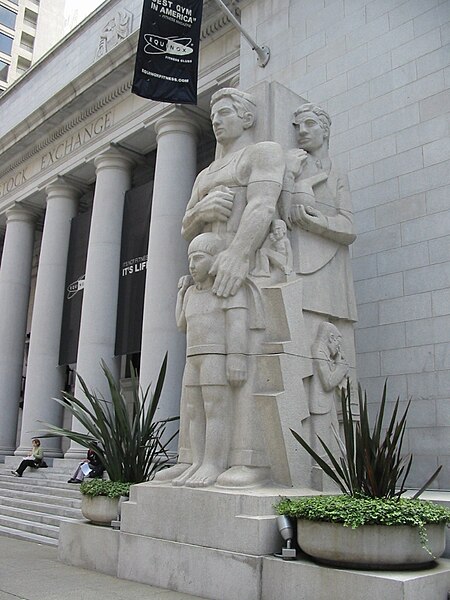Timothy Ludwig Pflueger was an architect, interior designer and architectural lighting designer in the San Francisco Bay Area in the first half of the 20th century. Together with James R. Miller, Pflueger designed some of the leading skyscrapers and movie theaters in San Francisco in the 1920s, and his works featured art by challenging new artists such as Ralph Stackpole and Diego Rivera. Rather than breaking new ground with his designs, Pflueger captured the spirit of the times and refined it, adding a distinct personal flair. His work influenced later architects such as Pietro Belluschi.
Pflueger in 1936, sketched by Peter van Valkenburg
Our Lady of the Wayside Church (1912), a rural Catholic church in Portola Valley
The newly built Pacific Telephone & Telegraph Company Building towered over its neighbors.
Ralph Stackpole's monumental stone figures top the entrance to 155 Sansome, the Stock Exchange Tower.
Ralph Ward Stackpole was an American sculptor, painter, muralist, etcher and art educator, San Francisco's leading artist during the 1920s and 1930s. Stackpole was involved in the art and causes of social realism, especially during the Great Depression, when he was part of the Public Works of Art Project, Federal Art Project of the Works Progress Administration, and the Treasury Department's Section of Painting and Sculpture. Stackpole was responsible for recommending that architect Timothy L. Pflueger bring Mexican muralist Diego Rivera to San Francisco to work on the San Francisco Stock Exchange and its attached office tower in 1930–31. His son Peter Stackpole became a well-known photojournalist.
Stackpole in his studio in 1940 photo by Peter Stackpole for LIFE magazine
"Tympanum group of Varied Industries" (1915)
Site placement of Industry (1932) shows its position at the right of the former San Francisco Stock Exchange building.
original 1915 version of Reverence








